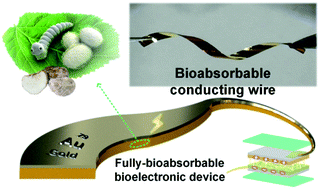Natural polymer-based bioabsorbable conducting wires for implantable bioelectronic devices†
Abstract
Biodegradable/bioabsorbable electrically conducting wires have an important role in the development of next-generation wearable microelectronics and implantable devices. The implantable devices, including conducting wires, must be biocompatible and biodegradable to avoid an inflammatory response and a second surgery. However, most conducting wires used in biomedicine are still conventional metallic wires. Herein, a new conducting wire with excellent conductivity, bioabsorbability, biocompatibility, and low weight was prepared from natural polymer and chromium/aurum (10/140 nm), providing the possibility to construct a fully bioabsorbable implantable device. The conducting wire substrate prepared from silk nanoribbons and konjac glucomannan has excellent mechanical properties. The wire resistance was approximately 8 Ω cm−1. The conducting wire exhibits an impedance of 140 Ω at 1000 Hz, which remains largely unchanged when the wire was immersed in buffer solution for ten days. Connection with a biodegradable triboelectric nanogenerator provides an integrated fully bioabsorbable energy generation device with a maximum output power density of 314.3 mW m−2. Compared with conventional metallic wires, this conducting wire has a higher transmission efficiency and biodegradability, better biocompatibility, and is more lightweight. This conducting wire and the integrated fully bioabsorbable energy generation device may be used in the fields of wearable electronics and implantable bioelectronics.



 Please wait while we load your content...
Please wait while we load your content...